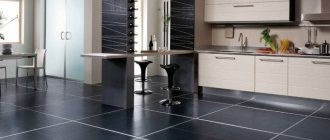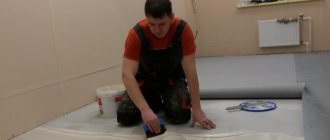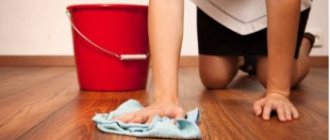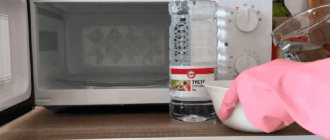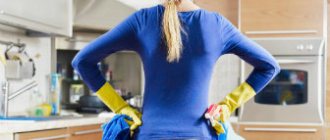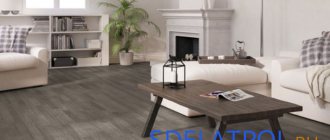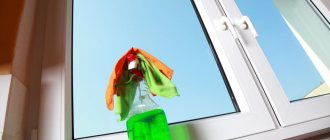How does the indoor microclimate affect linoleum?
Linoleum flooring is so versatile that it can be installed in any room, be it an apartment, a cottage or outbuildings. The service life of the material and its appearance will directly depend on operating conditions, including temperature and humidity indoors, that is, its microclimate. These characteristics can vary greatly depending on the time of year.
- In premises intended for permanent residence (house, apartment), a constant level of humidity and temperature suitable for residents is usually maintained. It is also optimal for using linoleum. But in a country house or outbuilding, the temperature is almost the same as outside - hot in summer and cold in winter, and humidity does not depend on the forecasts of the Hydrometeorological Center. Under such conditions, linoleum either softens, then hardens and becomes brittle, which is why it quickly deteriorates and loses its qualities.
- A linoleum covering laid on a concrete or wooden floor, installed in accordance with all building regulations on top of a high-quality waterproofing layer, will last quite a long time. But if we are talking about a room with hastily put together flooring without hydro- and thermal insulation, then linoleum under such conditions will quickly lose its ductility and strength.
The service life and quality of linoleum directly depends on the floor on which it was laid
- The residential building maintains a high temperature during the cold season due to heating. This inevitably causes condensation to form. If it’s frosty outside, the excess moisture freezes out. But in warmer weather they concentrate indoors, especially on the floor. Linoleum accumulates moisture, causing it to fade, become vulnerable to mechanical damage, and begin to delaminate.
Effective stain removal
Expert opinion
Natalya Osadchaya
When washing new or old linoleum, it is not recommended to use conventional dishwashing detergents. These degreasers can lead to disruption of the structural properties of the coating, in particular, to damage to the polyurethane layer, as a result of which the floor can begin to get dirty faster.
Over time, stubborn stains may appear on the floor surface. In the case of a surface without polyurethane, this risk doubles.
Wet cleaning of smooth or ribbed (rough) surfaces is carried out with water with the addition of a product suitable for PVC floor coverings. This will ensure that the floor maintains its original appearance and long life with a minimum of regular maintenance. The use of aggressive cleaning agents, especially for cleaning the relief coating, is not recommended, as is the use of abrasive substances (mechanical abrasion), since this can scratch the top layer.
If the surface is porous, it is recommended to wax the floor to prevent water from entering the coating, which subsequently cracks.
Household stains
During normal use, linoleum is subject to mechanical abrasion over time, and sometimes does not withstand other mechanical influences. In the most stressed areas, cracks may appear and dirt may become embedded in the relief. This affects the surface structure of linoleum. For these reasons, the coating should be carefully maintained. In places where there are heavy pieces of furniture (for example, beds), it is advisable to install a carpet. If regular maintenance is neglected, dirt builds up on the linoleum. A heavily soiled floor or ingrained dirt will not add comfort to your home...
Important! Due to the stress placed on the floor and the degree of contamination associated with it, it is recommended that basic cleaning of the surface be carried out at regular intervals.
Two stages of regular cleaning:
- Sweeping – sweep the floor regularly and use a vacuum cleaner. Focus on corners where dirt often accumulates.
- The washing up. It is recommended to wet clean every week using warm water and a suitable detergent. To obtain a streak-free effect and a shiny, cleaned floor, you can wipe it with a dry cloth.
Elimination of various substances
After washing linoleum, never apply waxes, thinners or organic solvents to it. PVC floors must be protected from all chemicals that can damage the coating. Even stubborn stubborn stains are best removed with water-based cleaners.
It is also necessary to protect linoleum from the following contaminants:
- asphalt;
- ink;
- dye;
- alcohol tinctures;
- preparations and substances containing dyes (Fukorcin).
Also be aware of rubber products that may cause unavoidable discoloration on the floor (e.g. rubber wheels, furniture protectors, shoe soles, etc.). If a stubborn stain appears (for example, pen paste, wood stain, etc.), regular cleaning and maintenance of the floor will not help. To remove it you will need a special product designed to remove stains. Stains should be removed as quickly as possible, as they can penetrate deep into the surface, making their complete removal difficult and sometimes even impossible.
The main enemies of linoleum
First of all, let’s figure out what products cause damage to linoleum and put them away.
- Do not use hot water to clean the floor. Of course, it copes with dirt more easily, but in addition, it causes swelling of the linoleum.
- Baking soda is great for cleaning surfaces, but not for linoleum. The alkali included in its composition creates microcracks on the surface, which expand over time and accumulate dirt.
Despite all the positive qualities, soda is not suitable for cleaning linoleum
- Any abrasive products - washing or cleaning powders - cause scratches on the surface.
- Do not use bleaches (especially chlorine-containing ones) and solvents. They discolor the pattern and can even corrode the linoleum to the base.
If you have difficult-to-clean stains on your flooring, it’s best to use the tips below.
Detergents for cleaning linoleum
Effective cleaning of linoleum floors from various stains requires the use of certain cleaning products, which are divided into two categories.
- All-purpose cleaners are the most common substances found in any home. Used to remove stains and other contaminants on coatings made of various materials, including linoleum.
- Specialized cleaning products - these are designed to remove stains on linoleum flooring. As a rule, they are more expensive than universal products, but they are much more effective.
How and with what to wash linoleum?
Expert opinion
Afanasyev E.V.
Chief editor of the pol-exp.com project Engineer.
Any cleaning products must meet certain requirements.
- Firstly, they should not contain alkalis, which can render linoleum unusable.
- Secondly, you should not use cleaning products with abrasive particles - the latter leave small scratches on the surface, damaging it and making stains even more difficult to remove.
- Thirdly, liquids for cleaning linoleum should not contain solvents or any other aggressive chemical compounds.
We follow the rules - we save the floor
Typical damage to linoleum and how to fix it yourself
Perhaps the most common damage to linoleum is cracks. While they are small, they can be covered with a chair or a small rug, in general, making them invisible. But if a crack has already appeared, it will certainly grow over time, and it will have to be patched.
- Increase its length by cutting just a couple of centimeters from both edges with a sharp knife.
- Gently clean out any debris that has accumulated inside.
- Treat the sections with alcohol to degrease.
- Apply glue to the inside (this can be Moment or special glue for linoleum).
- Place the coating firmly on the floor, press it down with something heavy and leave for 1–2 hours.
- After this, remove any remaining glue from the surface.
If the linoleum is torn, you need to replace the damaged area.
- Cut out an even square where the hole appeared.
- Try to select a piece of new linoleum so that the pattern completely matches.
- Remove all debris and degrease the surface with alcohol.
- Apply glue to a piece of linoleum, especially on the edges, and apply it to the floor. The joints must match completely.
It’s easy to replace a damaged area of linoleum, the main thing is to check that the pattern matches
Often linoleum fades and becomes stained. This is usually caused by high humidity. For example, you may notice such changes near the sink or in the area where your pet's water bowl sits. Honestly, it’s easier to prevent such damage by wiping the floor with a dry cloth in a timely manner. But if trouble has already happened, try washing the linoleum in the entire room with soap or vinegar solution. The whitish and yellow spots will fade and become less noticeable.
How to clean linoleum in the kitchen from various kinds of stains
For stains on linoleum, use various household chemicals or improvised means that are found in every home. The principle of operation is the same in all cases: a cleaning agent is applied to the dirt, after which the floor is washed first with soap and then with clean water and wiped with dry flannel.
What is used for this:
- Fat, including ingrained fat, is washed off with dishwashing detergents. Before use, the composition is diluted with water until foam forms.
- Traces from asphalt, rubber or bitumen, felt-tip pen, pen or paint, stains from coffee or iodine, rust are washed off with gasoline, turpentine and kerosene. Before starting work, you need to check the effect of the liquid on a small, inconspicuous area of linoleum, otherwise you can damage its top layer and erase the design.
- remove dark streaks from shoes and rubber . They just need to be wiped off the linoleum and washed with an all-purpose detergent.
- Stains from ink, felt-tip pens and brilliant green are removed with salt and vinegar. First, sprinkle the stain with salt, then moisten it with vinegar. After a few minutes, the salt is removed and the linoleum is washed.
- you get chewing gum off the floor by placing it on the gum, covering it with a cloth to prevent it from melting quickly, and after 10 minutes removing the gum from the floor with a knife or spatula.
- Iodine stains are wiped off with a damp cloth and potato starch.
- Mold is removed with chlorine-containing substances, which are applied to the linoleum on both sides, after which it is dried.
- Fresh stains from oil and alkyd paint are removed with sunflower oil. Old stains are removed with a solution of 20 g of laundry soap, 20 g of soda and 1 liter of warm water. Another option is solvent “646”, which penetrates under the paint, after which it is easily removed with a spatula.
- Traces of tape can be removed with glass cleaner or alcohol.
- Pet urine is removed with vinegar, vodka or lemon juice diluted with water in a 1:1 ratio.
Linoleum processing materials
It would seem, what secrets might there be in processing linoleum? Despite the simplicity and ordinariness of the material, they still exist.
How to wash the coating
It should be noted that after laying the floor covering, it must be cleaned exclusively using a dry method. If the floor covering is covered with a decorative element on top, along which residents often move, then the linoleum must be additionally treated using polymer spraying or a protective emulsion.
Important! Plain linoleum immediately shows stains of various origins, and therefore requires mandatory surface treatment.
Some time after installation, linoleum requires cleaning with a damp cloth or with the addition of soap products, previously well dissolved in water.
Cleaning surfaces with deep contamination
Various situations happen in life, and sometimes it happens that completely ugly and difficult to remove stains get on the linoleum, which can only be gotten rid of with the help of special linoleum cleaning products sold in household stores. Such chemicals should be applied with extreme care and meticulousness.
To disinfect the premises, you can use specially designed products in a strictly specified proportion, failure to comply with which invariably leads to damage to the linoleum and the need to replace it.
Important! Old and worn-out linoleum can be renewed and refreshed with milk, mixing it with water in equal proportions.
When mixing several detergents to clean a surface, it is recommended to ensure that they can be combined and that there are no fatal consequences. If such a warning is ignored, an unexpected reaction of the constituent products may occur with each other, which will certainly damage the surface.
Important! Linoleum should not be washed with hot water, soda, or alkaline detergents. The use of such products during cleaning makes the coating weak and brittle.
How to restore shine to linoleum?
Almost all linoleum cleaning products have one drawback - the shine effect does not last long. After 2-3 days, the floor covering, although it looks clean, becomes dull.
Types of polishes
What needs to be done to make the floor shine for a week or even longer? To do this, after wet cleaning, linoleum is treated with protective agents - polishes. They come in two types:
- metallized;
- non-metallized.
The former contain zinc ions, thanks to which they give the flooring a crystal shine. They are highly resistant to dirt. But metallized polishes have two disadvantages: high price and deterioration in performance in wet areas (for example, in the kitchen). Non-metallic polishes are cheaper, but wear out faster.
If your goal is to disguise isolated small scratches, you don’t have to buy an expensive polish. Rub the surface with a wax candle.
How to use polishes?
To restore the shine to old linoleum, you need to follow these steps.
- Carefully treat the floor using a special detergent for linoleum to remove old stains.
- Wash the coating with clean water without adding chemicals and wipe with a dry cloth. Make sure there are no streaks left on the floor. If you ignore this step, the polish will subsequently become cloudy and flake off.
- Apply polish to a microfiber mop. Treat the floor in straight lines parallel to the rays of light. Wait for the product to dry (usually 30-40 minutes).
- Apply a second layer of polish on the first in perpendicular layers. Wait 30-40 minutes again.
In the future, you can treat the linoleum with several more layers (but no more than 6) so that it becomes glossy. It is recommended to exclude any load on the coating within 8-10 hours. Try not to go into the room.
How to check if the polish is dry? Touch the linoleum with the back of your hand. If the skin sticks a little to the surface, then you need to wait a little longer.
Safe chemistry for linoleum
Special products wash linoleum until it shines without leaving streaks
When choosing a detergent, the main thing you should pay attention to is safety.
Clean water is sufficient for daily cleaning. Specialized household chemicals should be used no more than once a week, having first studied the instructions. Do not use powder detergents, they may leave scratches.
It is convenient to remove grease deposits on the kitchen floor with laundry soap. And to quickly remove dirt and add shine to the coating, you need to use drying oil. If you don’t have anything like this at hand, you can wash the linoleum in the kitchen with regular dish gel, which removes greasy stains well.
Products such as Mr. do a good job of removing stains. Proper, Mr. Muscle and others. The solution is added to water in the proportions indicated on the packaging and the floor is treated with a rag soaked in the composition.
